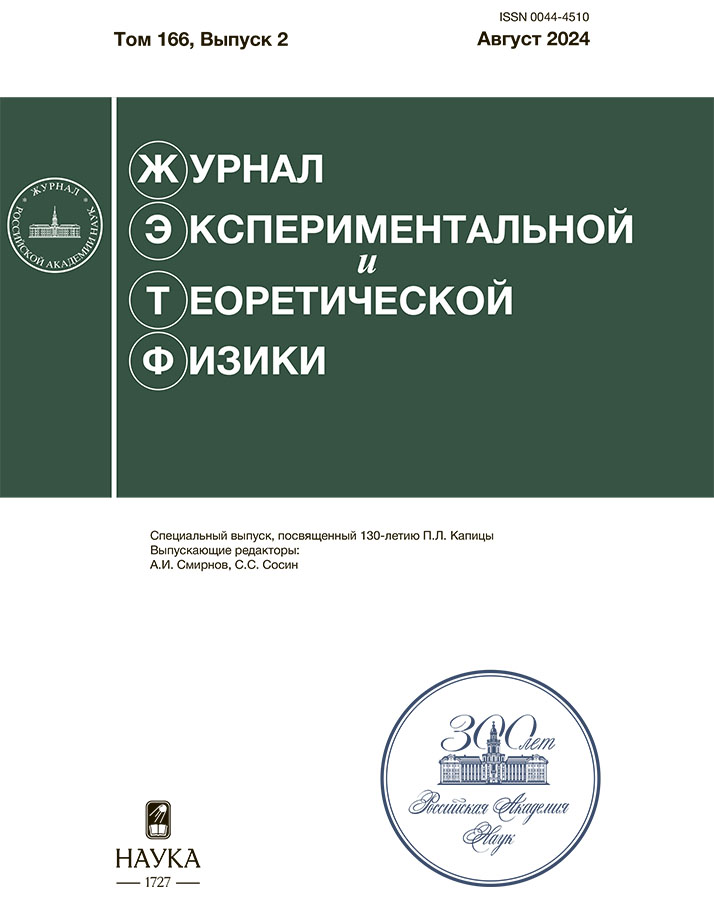VLIYaNIE AMPLITUDY MAGNITNOGO POLYa NA KINETIKU PEREMAGNIChIVANIYa MAGNITNYKh NANOChASTITs
- Authors: Zubarev A.Y.1, Iskakova L.Y.1, Musikhin A.Y.1
-
Affiliations:
- Уральский федеральный университет им. Б.Н. Ельцина
- Issue: Vol 166, No 2 (2024)
- Pages: 238-245
- Section: Articles
- URL: https://transsyst.ru/0044-4510/article/view/653843
- DOI: https://doi.org/10.31857/S0044451024080091
- ID: 653843
Cite item
Abstract
Теоретически исследовано влияние амплитуды магнитного поля на кинетику перемагничивания, а также магнитогипертермический эффект, продуцируемый однодоменной ферромагнитной частицей, иммобилизованной в немагнитной среде. Результаты расчетов, основанные на математически регулярной теории Крамерса, показывают, что в частице диссипация W энергии переменного магнитного поля может расти с амплитудой поля H0 быстрее, чем по квадратичному закону W ∼ H20 . Этот вывод, по крайней мере, в принципиальном отношении объясняет недавние эксперименты по магнитной гипертермии в системах обездвиженных частиц, где была обнаружена зависимость W ∼ Hγ0 , γ > 2.
About the authors
A. Yu. Zubarev
Уральский федеральный университет им. Б.Н. ЕльцинаЕкатеринбург, Россия
L. Yu. Iskakova
Уральский федеральный университет им. Б.Н. ЕльцинаЕкатеринбург, Россия
A. Yu. Musikhin
Уральский федеральный университет им. Б.Н. Ельцина
Email: antoniusmagna@yandex.ru
Екатеринбург, Россия
References
- Boczkowska and S.F. Awietjan, Tuning Active Magnetorheological Elastomers for Damping Applications, Materials Science Forum 636–637, 766 (2010).
- M.T. Lopez-Lopez, G. Scionti, A.C. Oliveira et al., Generation and Characterization of Novel Magnetic Field-Responsive Biomaterials, PLoS ONE 10, 7 (2015).
- B. Sung, M-H. Kim, and L. Abelmann, Magnetic Microgels and Nanogels: Physical Mechanisms and Biomedical Applications, Bioengineering and Translational Medicine 6, 1 (2021).
- Imran, A.M. Affandi, M. Alam et al., Advanced Biomedical Applications of Iron Oxide Nanostructures Based Ferrofluids, Nanotechnology 32, 42 (2021).
- M. Naghdi, M. Ghovvati, and N. Rabiee, Magnetic Nanocomposites for Biomedical Applications, Advances in colloid and interface science 308, 10277 (2022).
- Sharma, A. Jangam, and J. Low Yung Shen, Design of a Temperature-Feedback Controlled Automated Magnetic Hyperthermia Therapy Device, Frontiers in Thermal Engineering 3, 1131262 (2023).
- X. Liu, Y. Zhang, Y. Wan et al., Comprehensive Understanding of Magnetic Hyperthermia for Improving Antitumor Therapeutic Efficacy, Theranostics 10, 8 (2020).
- Wlodarczyk , S. Gorgon, A. Radon et al., Magnetite Nanoparticles in Magnetic Hyperthermia and Cancer Therapies: Challenges and Perspectives, Nanomaterials 12(11), 1807 (2022).
- M. Peiravi, H. Eslami, M. Ansari et al., Magnetic hyperthermia: Potentials and limitations, J. Indian Chem. Soc. 99, 1 (2022).
- J. Pan, Y. Xu, Q. Wu et al., Mild Magnetic Hyperthermia-Activated Innate Immunity for Liver Cancer Therapy , J.Amer.Chem. Soc. 143, 21 (2021).
- Ahmed, E. Kim, S. Jeon et al., Closed-Loop Temperature-Controlled Magnetic Hyperthermia Therapy With Magnetic Guidance of Superparamagnetic Iron-Oxide Nanoparticles, Advanced Therapeutics 5, 2 (2022).
- H. F. Rodrigues, G. Capistrano, and A.F. Bakuzis, In Vivo Magnetic Nanoparticle Hyperthermia: A Review on Preclinical Studies, Low-Field NanoHeaters, Noninvasive Thermometry and Computer Simulations for Treatment Planning, J.Hyperthermia 37, 3 (2020).
- V. Vilas-Boas, C. Flix, and E. Begona, Magnetic Hyperthermia for Cancer Treatment: Main Parameters Affecting the Outcome of in Vitro and in Vivo Studies, Molecules 25(12), 2874 (2020).
- Chang, M. Lim, J.A.C.M. Goos et al., Biologically Targeted Magnetic Hyperthermia: Potential and Limitations, Frontiers in Pharmacology 9, 831 (2018).
- R.E. Rosensweig, Heating Magnetic Fluid With Alternating Magnetic Field, J.Magn.Magn.Mat. 252, 370 (2002).
- Yu.P. Kalmykov, THe Relaxation Time of the Magnetization of Uniaxial Single-Domain Ferromagnetic Particles in the Presence of a Uniform Magnetic Field, J.Appl.Phys. 96, 1138 (2004).
- S. Poperechny, Yu. L. Raikher, and V. I. Stepanov, Dynamic Magnetic Hysteresis in Single-Domain Particles With Uniaxial Anisotropy, Phys.Rev.B 82, 17 (2010).
- A.P. Safronov, A.Yu. Zubarev, A.D. Maximov et al., Specific Loss Power of Epoxy Composites With Embedded Magnetite Particles, Europ.Phys. J. Special Topics 231, 1181 (2022).
- S. Dutz, M. Kettering, I. Hilger et al., Magnetic Multicore Nanoparticles for Hyperthermia-Influence of Particle Immobilization in Tumour Tissue on Magnetic Properties, Nanotechnology 22, 26 (2011).
- E.A. P?rigo, G. Hemery, O. Sandre et al., Fundamentals and Advances in Magnetic Hyperthermia, Applied Physics Reviews 2, 4 (2015).
- S. Odenbach and S. Thurm, Magnetoviscous Effect in Ferofluids, Ferrofluids. Magnetically controllable fluids and their aplications, Springer, Berlin (2002).
- М.А. Марценюк, Ю.Л. Райхер, М.И. Шлиомис, ЖЭТФ 65, 834 (1973).
- W. F. Brown, Jr., Thermal Fluctuations of a SingleDomain Particle, Amer.Phys. Soc. 130, 5 (1963).
Supplementary files











